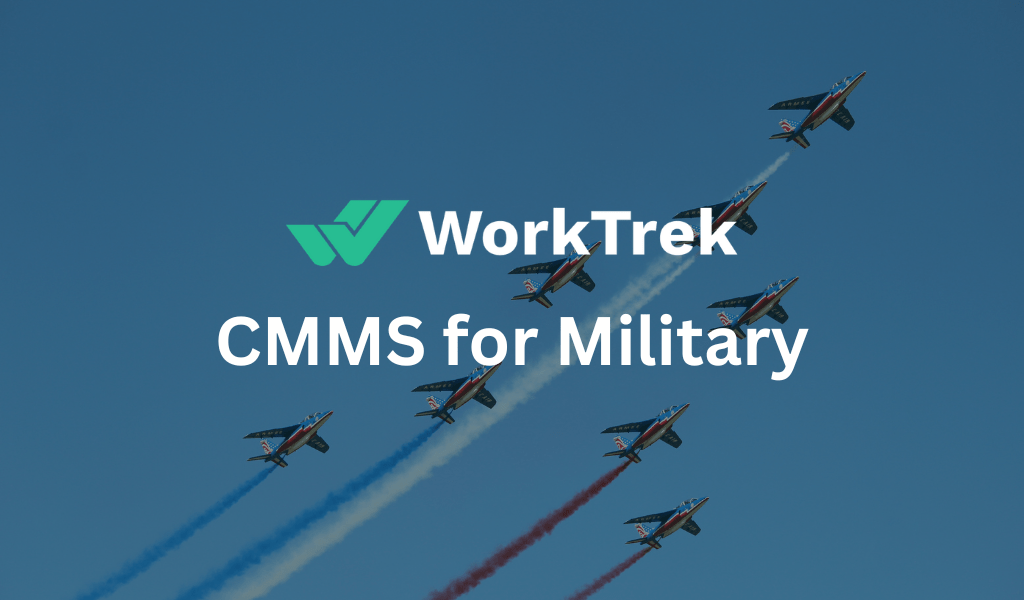Get a Free WorkTrek Demo
Let's show you how WorkTrek can help you optimize your maintenance operation.
Try for freeIntroduction
In the context of the military, CMMS stands for Computerized Maintenance Management System. A CMMS is a software-based solution used to manage and streamline maintenance operations for various assets, equipment, and facilities within military organizations. It helps automate and optimize maintenance processes, improve asset reliability, and enhance overall operational efficiency.
Military Logistics
Military logistics involves the planning, coordination, and execution of the movement, storage, and maintenance of military personnel, equipment, and supplies. It encompasses a broad range of activities aimed at ensuring that the right resources are available at the right time, in the right place, and in the right condition to support military operations effectively.

Key components of military logistics include:
Supply Chain Management: Managing the flow of goods and materials from suppliers to military units, including procurement, transportation, inventory management, and distribution.
Transportation: Organizing and coordinating the movement of personnel, equipment, and supplies by various modes of transportation, including air, land, sea, and rail.
Maintenance and Repair: Providing maintenance support for military equipment and vehicles to ensure operational readiness and extend their service life.
Warehousing and Storage: Establishing facilities for the storage, stockpiling, and distribution of military supplies and equipment.
Medical Logistics: Ensuring the availability of medical supplies, equipment, and personnel to support medical treatment and evacuation of casualties during military operations.
Personnel Support: Providing essential services and support to military personnel, including food, shelter, clothing, and administrative assistance.
Information Systems: Utilizing technology and information systems to track and manage logistics operations, including supply chain visibility, asset tracking, and inventory management.
Security and Protection: Implementing measures to safeguard military assets and personnel during transportation, storage, and distribution operations.
Effective military logistics is essential for maintaining operational readiness, sustaining military capabilities, and supporting mission success. It requires careful planning, coordination, and collaboration among various military units, government agencies, and allied partners to ensure that logistical support is provided efficiently and effectively, even in challenging and dynamic operational environments.

What is Military Maintenance Management?
Military Maintenance Management refers to the strategic planning, organization, coordination, and supervision of maintenance activities within military organizations. It encompasses all the processes and procedures involved in ensuring that military equipment, vehicles, infrastructure, and facilities remain operational, reliable, and safe for use.
Key aspects of military maintenance management include:
Asset Management: Tracking and managing all military assets, including equipment, vehicles, aircraft, ships, and infrastructure, throughout their lifecycle.
Preventive Maintenance: Implementing scheduled maintenance tasks to prevent equipment breakdowns and ensure optimal performance.
Corrective Maintenance: Addressing unscheduled repairs and breakdowns promptly to minimize downtime and restore operational readiness.
Predictive Maintenance: Utilizing data analysis and predictive modeling to anticipate maintenance needs and proactively address potential issues before they occur.

Resource Allocation: Efficiently allocating resources such as manpower, spare parts, tools, and facilities to support maintenance operations.
Regulatory Compliance: Ensuring that maintenance activities comply with relevant regulations, standards, and safety protocols.
Documentation and Reporting: Maintaining accurate records of maintenance activities, including work orders, maintenance logs, and inspection reports, to track asset performance and compliance.
Training and Skill Development: Providing ongoing training and skill development opportunities for maintenance personnel to enhance their capabilities and proficiency in maintaining military equipment and systems.
Effective military maintenance management is crucial for sustaining operational readiness, extending the lifespan of military assets, and minimizing overall lifecycle costs. It plays a vital role in supporting military missions, ensuring the safety and effectiveness of military operations, and maintaining a state of readiness to respond to various threats and challenges.

What is CMMS in the Military?
A CMMS is a software-based solution used to manage and streamline maintenance operations for various assets, equipment, and facilities within military organizations. It helps automate and optimize maintenance processes, improve asset reliability, and enhance overall operational efficiency.
Key features of a CMMS in the military context may include:
Asset Management: Tracking and managing military assets, such as vehicles, aircraft, weapons systems, and infrastructure, throughout their lifecycle.
Work Order Management: Creating, assigning, and tracking maintenance tasks and work orders, including scheduled preventive maintenance and unscheduled corrective maintenance.
Inventory Management: Managing spare parts, tools, and consumables inventory to ensure the availability of necessary resources for maintenance activities.
Maintenance Scheduling: Planning and scheduling maintenance activities based on asset usage, operational requirements, and maintenance priorities.
Resource Allocation: Optimizing the allocation of manpower, equipment, and materials to support maintenance operations effectively.
Asset Performance Monitoring: Monitoring asset performance, reliability, and maintenance history to identify trends, patterns, and areas for improvement.
Regulatory Compliance: Ensuring compliance with military regulations, standards, and safety protocols governing maintenance activities.
Reporting and Analytics: Generating reports and analytics to assess maintenance performance, identify areas for optimization, and support decision-making processes.

What Challenges Facing Army Logistics and How CMMS Can Help With Those Challenges?
Army logistics face several challenges, including:
Complex Supply Chains: Military operations often involve complex and dynamic supply chains, with multiple suppliers, transportation modes, and logistical nodes. Coordinating these supply chains and ensuring timely delivery of resources can be challenging, especially in remote or hostile environments.

Limited Resources: Military logistics must operate within constrained resources, including manpower, equipment, and budgetary allocations. Optimizing resource utilization while meeting operational demands is a constant challenge.
Asset Management: Managing a diverse range of assets, including vehicles, weapons systems, equipment, and facilities, requires effective tracking, maintenance, and inventory management to ensure operational readiness and mission success.
Maintenance Efficiency: Efficient maintenance is essential for sustaining operational readiness and extending the lifespan of military assets. However, managing maintenance tasks, scheduling, and resource allocation can be complex, especially in high-tempo operational environments.
Information Management: Military logistics rely heavily on accurate and timely information for decision-making. However, disparate systems, data silos, and communication challenges can hinder information sharing and coordination across different units and organizations.
A CMMS can help address these challenges in several ways:
Improved Asset Visibility: CMMS provides real-time visibility into the status, location, and condition of military assets, enabling better asset tracking, inventory management, and resource allocation.
Streamlined Maintenance Operations: CMMS automates maintenance processes, such as work order generation, scheduling, and tracking, streamlining maintenance operations and reducing downtime.
Optimized Resource Allocation: CMMS helps optimize the allocation of manpower, equipment, and materials by providing insights into maintenance needs, asset performance, and resource availability.
Enhanced Data Management: CMMS centralizes maintenance data, providing a single source of truth for maintenance activities, asset history, and performance metrics. This improves information management, decision-making, and coordination across military logistics operations.
Predictive Maintenance: Advanced CMMS systems can incorporate predictive maintenance capabilities, using data analytics and machine learning algorithms to anticipate maintenance needs, prevent equipment failures, and optimize maintenance schedules.
By addressing these challenges, CMMS can help improve the efficiency, effectiveness, and reliability of army logistics operations, ultimately enhancing operational readiness and mission success.

Conclusion
CMMS software helps military organizations streamline their maintenance operations, reduce downtime, extend the lifespan of assets, and enhance operational readiness. It provides visibility into maintenance activities, improves resource utilization, and supports data-driven decision-making to achieve mission success effectively.










